More photos of Yoichiro Kawaguchi's robot designs on display at Yushima Seid? temple in Tokyo:
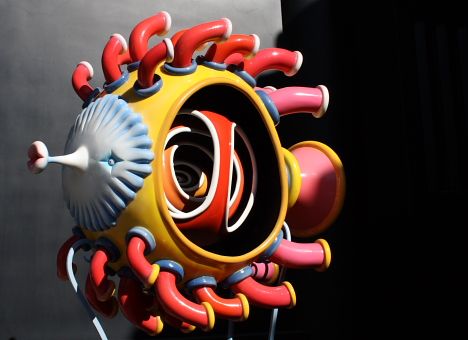
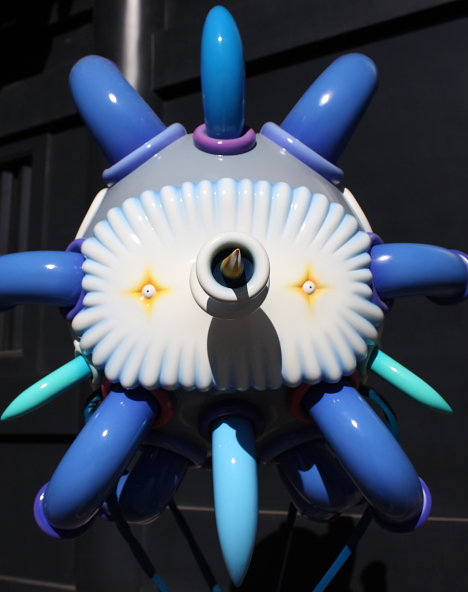
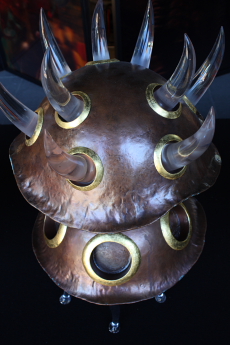
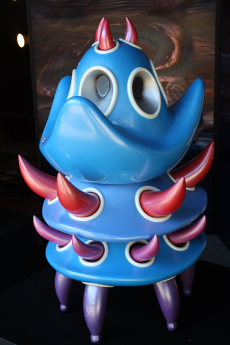
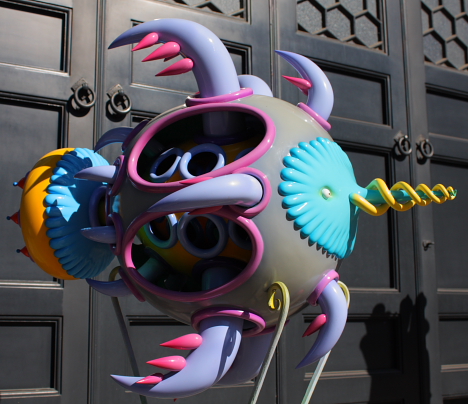
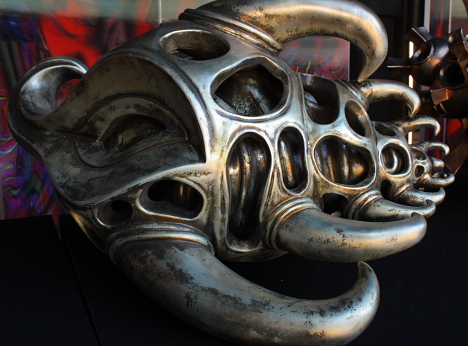
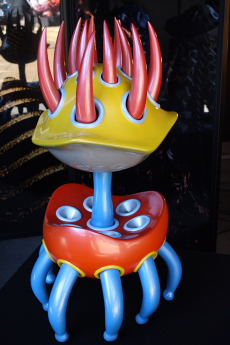
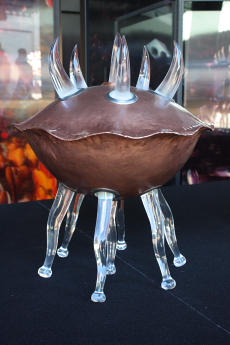
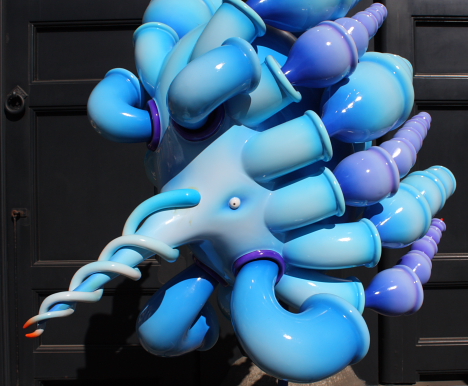
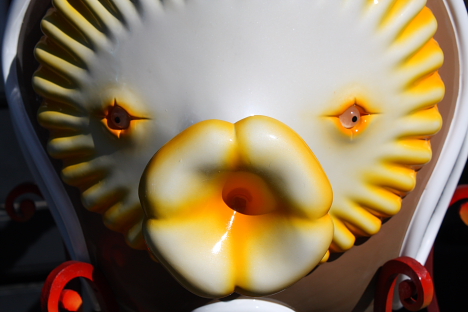
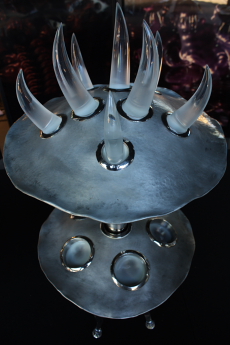
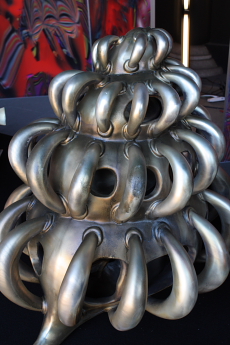
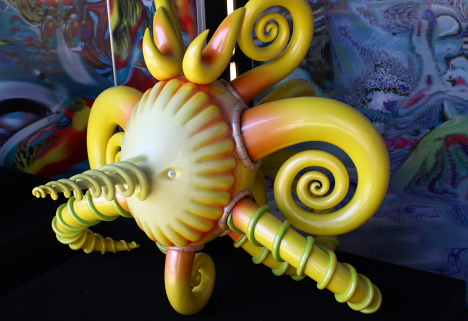
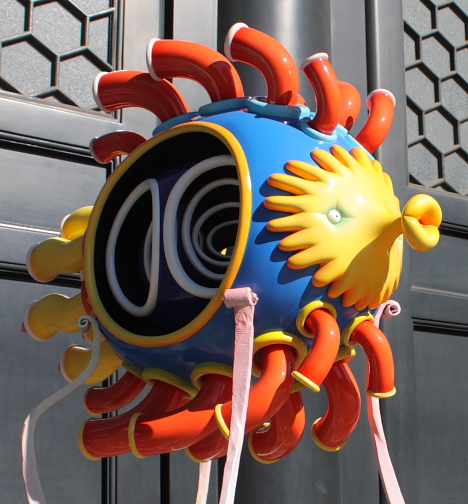
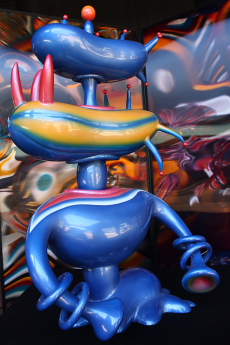
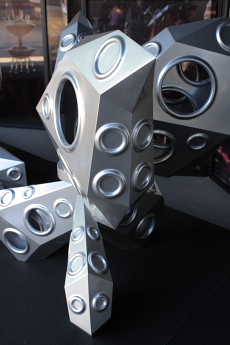
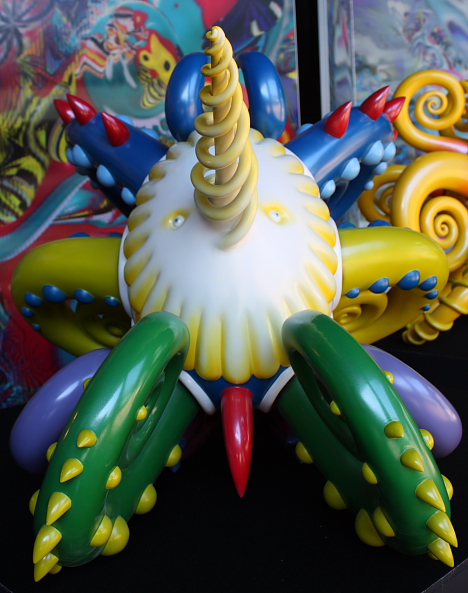
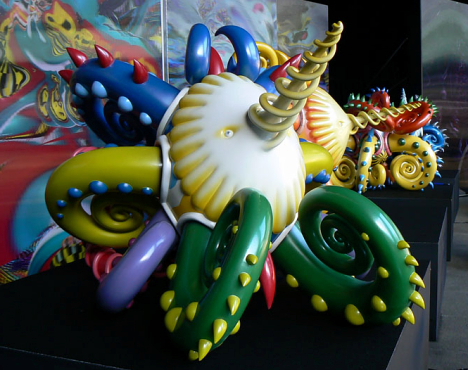
A University of Tokyo research team led by professor/computer graphic artist Yoichiro Kawaguchi is developing robots designed to imitate primitive life forms. Mockups have been put on display at a Confucian temple in Tokyo, and working versions of the robots are scheduled for completion in two years.
According to the researchers, these robots are being developed as a way to explore artificial life and gain insights into how living things survive in a world governed by the law of the jungle.
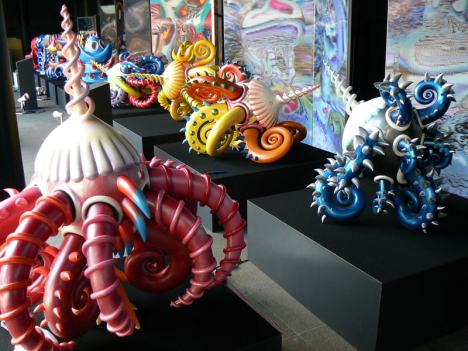
Kawaguchi and his team are developing a basic reflex system for the primitive artificial life forms, as well as a visual processing system equipped with eyes that recognize and instinctively track certain objects.
In addition, the researchers are working to create powerful biomimetic actuators for locomotion. As part of their research, Kawaguchi and his team have conducted computer simulations to investigate the use of neural oscillators in a locomotion system that imitates the way centipedes crawl. They are also working on simple, mechanical tentacles that extend and contract to move the robot in a specified direction. If all goes according to schedule, they will have a fully functional robot in two years.
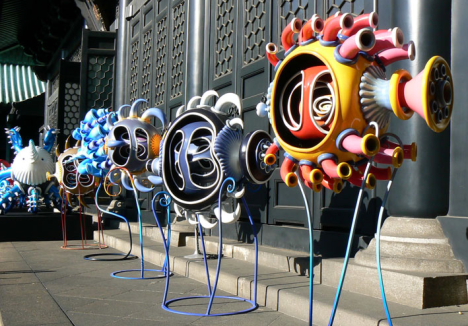
With a more thorough understanding of how primitive life forms survive, the researchers believe they can provide robots with a better ability to move, hunt, sense danger, and escape. They suggest that strong survival and hunting skills can be put to use in applications ranging from security guard dog robots to swarm robots tasked with exploring the surface of an alien planet.
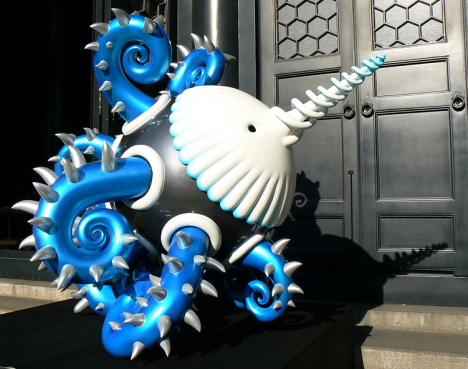
Kawaguchi, a professor at the University of Tokyo Graduate School of Interdisciplinary Information Studies, has become known for creating artistic computer graphics programs that exhibit "lifelike" behavior such as self-organization and self-propagation. The robot mockups, which are three-dimensional models of his previous computer graphics work, will remain on display at Yushima Seid? temple until February 8.
[Source: Robot Watch]
UPDATE: More photos HERE.

Japanese scientists have successfully cloned a prize beef cow more than 13 years after it died, it was announced on January 6. The legendary steer -- named "Yasufuku" in his first life (1980-1993) -- is regarded as the father of Hida beef, a high-quality meat from Gifu prefecture famous for its marbled texture and rich flavor.
During his 13-year life, the prize bull's sperm was used to sire 40,000 calves, helping to establish Hida as a high-class brand of beef. It is believed that more than 30% of the nation's Japanese black cattle can trace their roots back to Yasufuku.
To produce the clones, researchers from the Gifu Prefectural Livestock Research Institute and Kinki University (Osaka prefecture) employed a somatic cell nuclear transfer method using the nuclei of cells extracted from the bull's testicles, which had spent 13 years in deep-freeze. The first clone of Yasufuku was created in 2007. In all, four clones of Yasufuku have been born, although one died from complications after birth.
The results -- which were scheduled to be published in the US journal PLoS ONE on January 8 -- suggest it is possible to "resurrect" animals valued for their high-quality meat, long after they have died. Some suggest the cloning method can also be used resurrect prize pigs and horses.
The rebirth of Yasufuku follows the recent success of another cloning experiment involving mammals held in long-term frozen storage. In November 2008, a RIKEN research team cloned a mouse from a carcass that spent 16 years in a freezer.
Teruhiko Wakayama, the RIKEN genetic engineer who led the effort to clone the frozen mouse last year, reacted to the news of the cloned frozen cow. "I was surprised to learn that the researchers found usable cells in the frozen tissue," said Wakayama. "[Their findings suggest] it is now possible to clone cows from delicious beef found on the supermarket shelf."
News of this latest cloning success comes as the Japanese government grapples with whether or not to allow cloned animal products into the food chain. The Cabinet Office's Food Safety Commission is currently looking at scientific data from a variety of Japanese and foreign sources in an attempt to evaluate the safety of cloned animal products. The commission is scheduled to present its decision to the Ministry of Health, Labor and Welfare later this year. Lawmakers will then have the final say on whether or not to approve the sale of cloned meat to Japanese consumers.
In 2008 (between January and September), researchers in Japan are known to have created 557 somatic cell cow clones. In response to consumer distrust of cloned meat, the Ministry of Agriculture, Forestry and Fisheries (MAFF) currently requests research institutions to take voluntary measures to prevent cloned cows from ending up in the food supply.
[Source: Mainichi]
The clione, a.k.a. sea angel, is a cute, translucent swimming sea slug that glides gracefully through icy ocean waters by flapping a pair of appendages that resemble tiny angel wings. Don't let the innocent, angelic look fool you, though -- the clione is a vicious demon come feeding time.
The Clione limacina species preys on its shelled cousin, the sea butterfly (Limacina helicina). When the hungry sea angel spots a suitable target, it lunges forward and rapidly unfurls a halo of six hooked tentacles from its head, locking its prey in a death grip. Slowly, the clione sucks the victim's body out of its shell, swallowing it whole.
Here is some video of a bioluminescent deep-sea siphonophore -- an eerily fantastic creature that appears to be a single, large organism, but which is actually a colony of numerous individual jellyfish-like animals that behave and function together as a single entity. The individual units, called zooids, all share the same genetic material, and each performs a specialized role within the colony. The best-known siphonophore is the poisonous Portuguese Man o' War (Physalia physalis), which lives at the surface of the ocean, unlike the one shown in this video (filmed at a depth of 770 meters). Some siphonophore species can grow up to 40 meters (130 ft) in length.
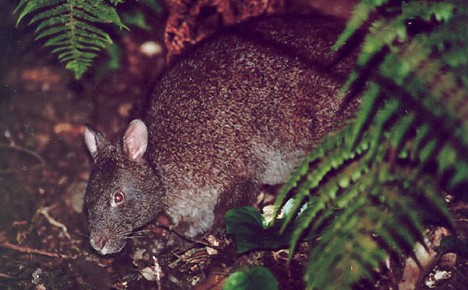
The Amami rabbit -- a threatened species found only in the Ryukyu Islands -- may become Japan's first endangered animal clone. Scientists at Osaka's Kinki University have cloned an embryo of the endangered rabbit and are awaiting its birth next month, it was announced earlier this week.
The Amami rabbit (Pentalagus furnessi) is a nocturnal, forest-dwelling "primitive" rabbit with dark fur, short legs, large curved claws and small ears. Found only on the islands of Amami-Oshima and Toku-no-Shima, it is sometimes called a "living fossil" for its resemblance to ancient rabbits that once inhabited the Asian mainland. The Amami rabbit's dwindling population -- now estimated at between 2,000 and 5,000 -- has earned it a spot on Japan's endangered species list.
To produce the clone, researchers took a cell from the ear of a dead Amami rabbit and injected it into the unfertilized egg of an ordinary lab rabbit. After the egg developed into the cloned embryo, researchers inserted it into the oviduct of a lab rabbit surrogate. The clone will be born in the coming weeks if the pregnancy comes to term. The chances of success are slim, though, as cloning pregnancies typically have a high failure rate. However, the scientists are prepared to repeat the process until a clone is born.
Although some people see cloning as a promising tool for restoring endangered populations when natural breeding is not possible, others argue it is more important to address the actual causes of the population decline. Deforestation and road accidents are major reason for the Amami rabbit's decline, as is the predatory mongoose, which humans released on the islands to control the snake population.

Pet dogs and cats also pose a danger to the species. In June, motion-sensitive cameras set up to monitor Amami rabbit activity on the island of Amami-Oshima captured the image of a feral domestic cat dragging a freshly killed carcass through the forest.
If the experiment succeeds, the Amami rabbit will join a growing list of endangered animals that have been cloned. Previous examples include the Asian gaur (a rare ox native to India and Burma), which died two days after it was born in the US in 2001, as well as the European mouflon (a Mediterranean wild sheep) and the Junqueira cow (Brazil).
Regardless of the outcome, the researchers suggest a degree of caution. Although cloning may potentially be used to preserve rare species, little is known about the long-term environmental impact, they said.
[Source: Asahi]
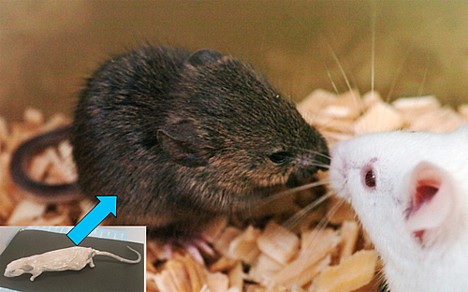
Is the second coming of the woolly mammoth near? Possibly, say researchers at Japan's Institute of Physical and Chemical Research (RIKEN), who have successfully cloned mice from carcasses that spent years in a deep freezer.
A RIKEN research team led by genetic scientist Teruhiko Wakayama successfully demonstrated a promising new cloning technique by replicating frozen laboratory mice whose cells were severely damaged after 16 years in permafrost-like conditions (-20 degrees Celsius). The technique might one day be used to resurrect mammoths and other extinct species, according to the researchers.
Here's some video from ANN News:
Scientists have long discussed the possibility of resurrecting extinct animal species by cloning carcasses preserved in ice, but existing techniques do not work with dead, freeze-damaged cell tissue. However, the RIKEN researchers were able to extract nuclei from the ruptured brain cells of the frozen mice after breaking down the tissue in a culture solution. Then, using the conventional nuclear transfer technique (which involves inserting cellular material from the frozen mice into the egg cells of healthy mice), the researchers created embryonic clones from the extracted brain cell nuclei. After that, the researchers established embryonic stem cell lines from the cloned embryos, which they used to produce four cloned mice.
When the clones reached maturity, they mated with other mice to produce healthy offspring.
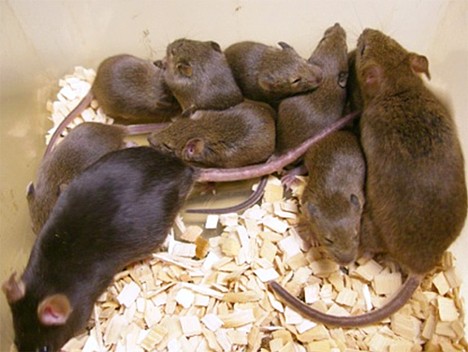
Healthy offspring of cloned mice
The ability of clones to reproduce is a promising development for those interested in resurrecting extinct species.
Mammoths top the list of extinct animals that scientists will try to clone, primarily because many preserved specimens have been found buried in ice. In July 2007, a well-preserved frozen baby mammoth discovered in the Siberian Arctic was shipped to researchers in Japan.
"There are many technical challenges involved in resurrecting a mammoth," says Wakayama. "But we have shown that the nuclear transfer method can be used to create healthy clones, even when the animal's cells have been damaged by permafrost-like conditions."
Meanwhile, Kinki University biology professor Akira Iritani is pleased with the development. Iritani, a leading member of the Mammoth Creation Project -- a Japanese organization that aims to resurrect the woolly mammoth by cloning frozen specimens -- estimates as many as 10,000 frozen mammoth specimens lie buried in ice around the world, waiting to be cloned.
Iritani also coordinates the "Pleistocene Park" project, which aims to set up a Jurassic Park-like sanctuary in northern Siberia populated with resurrected mammoths and other creatures that roamed the Earth 20,000 years ago. The envisioned park would cover an area twice the size of Japan and include woolly rhinos, Siberian tigers, steppe lions, giant deer, ancient foxes, and ancestors of the Siberian horse.

Smooth nylon shrimp (Heterocarpus laevigatus) inhabiting the dark depths of the Pacific employ a brilliant method of defense. When threatened with attack, the creature spits a cloud of bioluminescent blue fluid from its mouth, temporarily blinding its predator and allowing escape.
This rarely seen footage of the smooth nylon shrimp's defense mechanism in action was shot at the Okinawa Churaumi Aquarium.
See also:
- Video: Tremoctopus defense mechanism
- Video: Three bioluminescent sea creatures
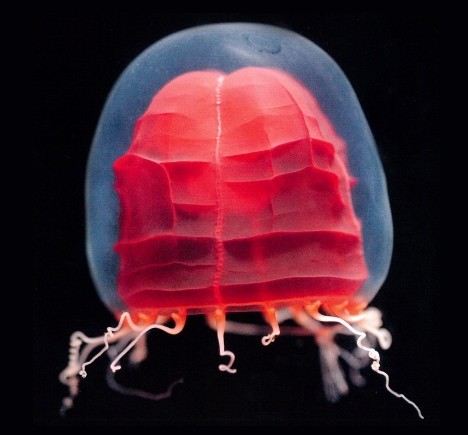
Red paper lanterns, or aka-chochin, are a familiar sight on the city streets of Japan, where they typically hang at the entrances to cheap pubs, capturing the attention of passersby. The ocean, however, is home to a different variety of red paper lantern -- an unusual species of deep-sea jellyfish.
Officially named Pandea rubra, the red paper lantern medusa (aka-chochin kurage) was first discovered in the Bering Sea in 1913, but details about its distribution and life cycle have long remained a mystery. In recent years, the creature has caught the eye of researchers at the Japan Agency for Marine-Earth Science and Technology (JAMSTEC) armed with high-definition video cameras.
Using manned and unmanned submersibles, the researchers have collected over 100 hours of high-definition footage showing more than 60 specimens of the jellyfish in waters from northeastern Honshu to Okinawa, at depths ranging from 500 to 1,000 meters. Here is some raw video:
The red paper lantern medusa has a transparent, bell-shaped hood measuring about 10 centimeters in diameter and 17 centimeters from top to bottom, with between 14 and 30 tentacles that extend up to 6 times the length of its body. Inside the transparent hood is a deep red colored mantle that can crumple up or expand like a paper lantern, hence the name. JAMSTEC researcher Dr. Dhugal Lindsay is credited with coming up with the name.
The gelatinous creature is commonly found at depths of between 450 to 900 meters in warm and temperate waters around the world. Observations have been reported in the Antarctic Ocean, but never in the Arctic Ocean.
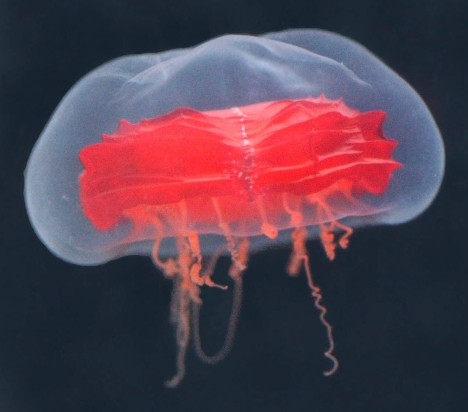
The JAMSTEC videos suggest that a variety of sea creatures regard the red paper lantern medusa as a safe place to establish temporary residence. In the video, the developing larvae of shrimp and sea spiders can be seen hitching extended rides on the jellyfish.
"We didn't expect to find such a variety of organisms attached to the jellyfish," said Dr. Dhugal Lindsay. "Humans apparently are not the only ones attracted to red paper lanterns."
[Source: Mainichi]